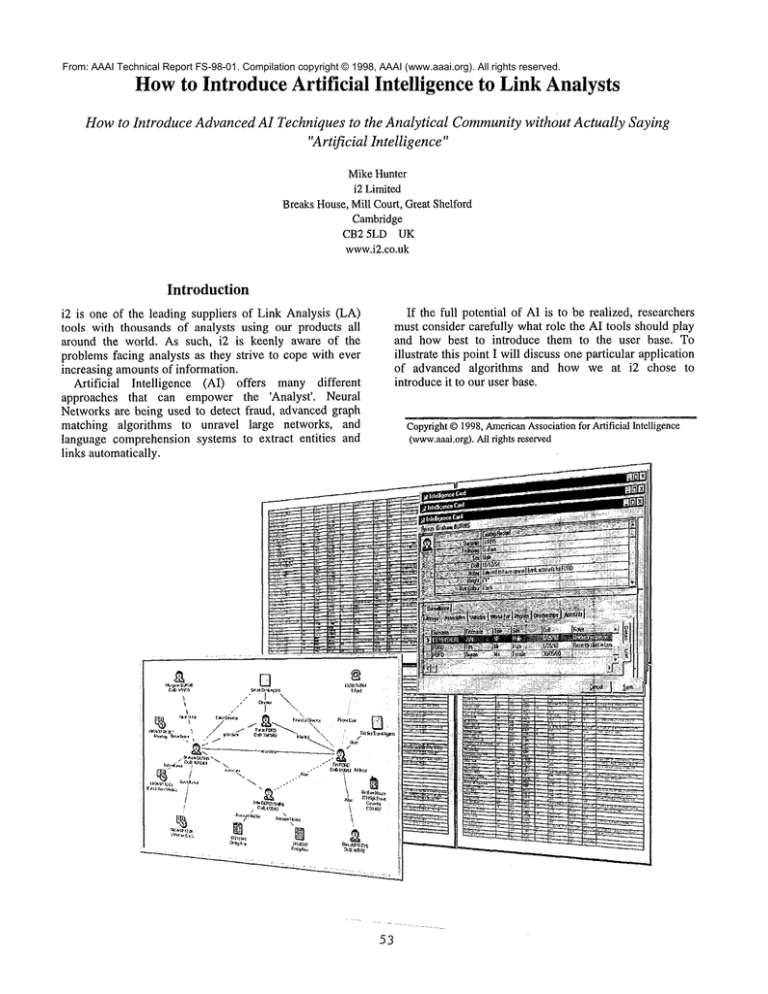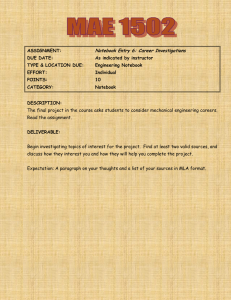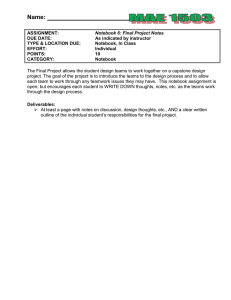
From: AAAI Technical Report FS-98-01. Compilation copyright © 1998, AAAI (www.aaai.org). All rights reserved.
Howto Introduce Artificial
Intelligence to Link Analysts
Howto Introduce Advanced AI Techniques to the Analytical Communitywithout Actually Saying
"Artificial Intelligence"
Mike Hunter
i2 Limited
Breaks House, Mill Court, Great Shelford
Cambridge
CB2 5LD UK
www.i2.co.uk
Introduction
If the full potential of AI is to be realized, researchers
must consider carefully what role the AI tools should play
and how best to introduce them to the user base. To
illustrate this point I will discuss one particular application
of advanced algorithms
and how we at i2 chose to
introduce it to our user base.
i2 is one of the leading suppliers of Link Analysis (LA)
tools with thousands of analysts using our products all
around the world. As such, i2 is keenly aware of the
problems facing analysts as they strive to cope with ever
increasing amounts of information.
Artificial
Intelligence
(AI) offers many different
approaches that can empower the ’Analyst’.
Neural
Networks are being used to detect fraud, advanced graph
matching algorithms to unravel large networks, and
language comprehension systems to extract entities and
links automatically.
Copyright©1998,American
Associationfor Artificial Intelligence
(www.aaai.org).
All rights reserved
53
The Role of AI
A Typical
Analysis is currently primarily a manualprocess. By this I
do not mean that the majority of analysts do not use
computers. Far from it; i2 has itself demonstrated that
software is a key ingredient in a modernanalytical tool-set.
Rather I mean that the key processing of the source
information still takes place in the mind, rather than the
CPU.The software maycollect, store, index, retrieve and
display the information; but the humananalyst is required
to understandit, to realize its significance, to assimilate it
into a ’mental model’ of the scenario and to draw the
appropriate inferences.
The problemsthat analysts address have proveddifficult
to automate for manyreasons. They are usually ill defined,
complex, create large volumesof data and differ widely
from one exampleto the next (each requiring its ownrealworld knowledgethat the analyst must learn rapidly). The
source information is frequently of dubious quality (often
including mis-information) and must at least be treated
with the appropriate level of skepticism. It also arrives at
the analyst in a whole variety of formats include a
significant proportion of free text. These qualities do not
lend the area easily susceptible to automatedapproaches.
Successful Link Analysis software producers have todate recognized this problem and concentrated on
supporting the analyst’s work rather than attempting to
automateit. But it is clear that existing algorithms are of
great utility. At a recent international analysis conference
held in the UKI defined the term ’Assisted Analysis’ as:
Problem
Link Analysis tools are frequently used to capture,
visualize and analyze telephone call records. A simple set
of data might be visualized as:
GI~23154732
7/’/425
\
¯
l
/
~’O.lS \ "~ ~ /
7
2.13
.01475 ~74~
~
..~
~:
/
i
\
1-10
010 "
i
[
123
2.21 3:10 3.40
012~3825~56
~-~
~
017~~Q3715
~
OlEO43~1715
Unfortunately such simple data sets are rarely useful. The
chart shownhere is far moretypical of somethinga tactical
link analyst might assemble.
The processing of potentially large sets of data using a
variety of automatic methodsto identify specific areas of
interest leadhzg to subsequentmanualanalysis.
By this definition I wished to emphasize that to gain
acceptance amongst the analytical community the new
techniquesshould, at least initially, play a role subservient
to that of the analyst - suggesting new avenues of
exploration rather than dictating the next step. In the
1980’s Prof. Donald Michie of Edinburgh University
coined the phrase ’Intelligence Amplifiers’ to describe the
role that KnowledgeBased Systems should play. I would
suggest a suitable phrase to describe the best role of AI in
LAmight be ’Analysis Amplifiers’.
54
S ca!e__d__up...thece.
n~alp ortion_o_f
_t_hischaLt_
_looks.
!ike:
or after re-arrangement:
i
’,
. .:~.’~e._~..
. "~-’~
=--.,,._\~
i
In
¯ .-’~
~
am
///////~
....
o’.
....
1
7~21191
y/
....
l~:3l 544211
Identifying such a tight grouping in a large network
without automatic assistance is practically impossible. But
the software cannot go onto explain the significance of the
grouping; that is the task of the subsequent manual
analysis.
These pictures are included to illustrate the kind of
assistance already provided to modemanalysts. What is
clear is that the precise nature of the assistance required
varies widely between analysis tasks. The challenge is to
find a route by which such advanced functionality can be
added to existing tools in a seamless and yet flexible
manner.
Clearly any AI applications that are addressing the area of
LAmust be scalable. Not only can the existing commercial
LAtools, like i2’s own, cope with large data volumes, but
they offer various tools to assist with analysis. For
example, they can efficiently re-organize the entities into
layouts that reveal the underlying topology and key
connectingentities:
AnArchitecture to SupportAI Approaches
Or they can examine a network and identify the most
tightly boundclusters, which might in this case suggest a
set of individuals acting as a group. For example, the most
tightly boundcluster in the abovechart, shownat the same
scale, is:
Analysts are now accustomed to commercial Link
Analysis products, like i2’s Analyst’s Notebook,that are
easy to use, robust, can integrate with existing databases
and are capable of running on sensible platforms. If the
newAI techniques are not to be stillborn, the prototypes
must be constructed on top of existing proven platforms
and tested on real pieces of work. The credibility of the AI
techniques must not be endangered by experimental
prototypes intended only for short-term use.
Luckily a variety of componentbased architectures now
exist that allow products to be constructed in a
compartmentalizedmanner, and for blocks of functionality
to be added to existing applications incrementally. These
include COM,CORBA
and Java/JavaBeans. To illustrate
the approach I will discuss howthe latest version of i2’s
owncore product has been implemented.
55
Container Application
LinkData
Control
LinkView
I
contro,:"i]
Connector
IDa
==
Palette
Control
:
Palette1
View1
View2
Figure 1 Link NotebookCOMArchitecture
Version 5 of i2’s Link Analysis product, the Link
Notebook, consists of a C++wrapper containing a set of
Microsoft COMcomponents.
Each of the six components provides different
functionality. The LinkDatacontrol, for example, manages
the network of entities and links whilst the LinkView
control displays it. The layout control includes several
algorithms for arranging the networkin different ways.
Component-based approaches can support several
different product architectures. In the case of i2’s Link
Notebook,for example,there are three different options:
.
jr~N-~telx~ok
Fie Ed~V’~ewIns-ed FormatTools AnalysisWindow
Help
I .......
I
I
An external programrunning as a peer with the Link
Notebook, communicating with it through the COM
Interface (see Figure 2)
Figure
.
An additional ’plug-in’ component,written in Visual
Basic, C++ or any other ActiveX compliant
development platform, that runs within the Link
Notebook process but extends the Notebook’s
functionality (see Figure 3)
.
3 Link Notebook Plug-in
Anexternal application that incorporates a subset of
the Link Notebook’s own components to provide Link
Analysis technology within that application (see
Figure 4).
File Edit ViewInsert FormatToolsAnalysisWindow
Help
O Application
O ChartColleclJon
O App’nCommands
O Chart
O Database
0 Entities
/
O Links
o Styles
0 Att~bute Classes
0 ChartItemlterators
-- -O EntityTypeCollection
Figure
2 COMInterface
Link with the Link Notebook
56
Component
/
/
I
|
"L
!
l
I
Lir~ Notebook
File
o c~.
E~ View I~ed
~t Tools ~s~ W/~w Help
0 Database |
--
~ Links
¯ -o sty~ l
~O
0 Apprcation
0 ChartColection
{
!
!
i
etc..
0 App’nCommands
E:~arl~b.lab "
%-o:.-----,,
0 Chad Commands
0
~s~
|
|
o E~i,~
l
l
0 Links
o s~
0 ,N1~io,~eClasses |
0 Chart item Iterators ~f
...........
Figure
4 Link Notebook Components within
Whicheverarchitecture is chosen, the object-oriented
COMInterface
is integrated
into the standard
programming environments.
The entity-clustering algorithm discussed above is an
example of architecture 2. The algorithm examines the
topology of the networkto suggest tightly boundclusters.
It is implemented as an additional,
and completely
separate, C++COMcomponent that is added to the core
Link Notebook simply by registering its existence and
declaring the functionality it offers. Oncea componentis
so registered, the Link Notebookautomatically detects its
presence and offers it to the analyst like any other piece of
functionality.
il:: [design]- [ObiectBrowse1]
~i.
a Container
/
/
t
Application
Object Oriented COM
interface). It can add, remove, edit,
moveor in any other way interact with the elements in the
link charts. The user can control the algorithm through a
set or parameters edited in a famifiar forms-based
interface.
Architecture 3 allows new systems to be constructed by
mixing and matching sets of existing and proven
components.For example, all of the British Police forces
will shortly begin using a new tool to run major
investigations called HOLMES2.
This investigative system
utilizes a subset of the i2 componentsmentionedabove to
provide the users with link analysis capability within the
Ilr~ I;
i2Unk[]at eU’o
:i
Classes
Lt~EnhtY
p
e
id
LNEnt~tylterator
identity
LNEnt~yldergeResult
itemT’~e
a" ~3 LNEntity£Me
label
LNEntttyType
labellstdenttty
~j LNEnfityTypeCoNection
IinkedEnds
LNEntJtyTyp
eEn&y
linkedEnt~es
Z:I:
LNFieldOefinition
~ links
~ :~’~. MergeEntJty
~,J LNFont
~,~ LNGraphicViewporl
~’~ Move
~ MoyeCard
LNIcon
~J LNlconlterator
~, PasteAltdbuteValue
~ ~lcon~e
~ ~.~ Rem~b~e
c~ass
U~En~’y
Merr2)erofi2LinkgataLib
:[:!-:iS-i::
:.1
’~/
~’<" I~ I
}
__-
mainapplication.
At i2 we are now working on a number of additional
componentsperforming a variety of tasks, some of which
require AI approaches. As soon as each componentreaches
maturity it will be integrated with the core product as
described above. This approach allows an unprecedented
level of extensibility and flexibility. Newcomponentscan
use any of the latest AI techniques to interact with and
manipulate the content of the link charts. And as the
commercialtools support a documentedinterface, external
researchers can write the components with little or no
l
~l
~Jl
: :-i---- -~::-I
: :: :::
._11!i
::~
The user is unaware of the separate nature of the
component. It is invoked from a standard menu and can
interact with the link charts behind the scenes (via a full
57
support from the company offering
platform.
the commercial
Conclusion
If it is to be accepted, researchers need to consider
carefully how they introduce AI techniques to the
analytical community.They should look to:
¯
’amplify’ the role of the humananalysts rather than
threaten them with ’automation’
¯
utilize the existing, acceptedanalytical tool sets rather
than seeking to replace themwith immaturetools
¯
workwith real clients on real problemsto ensure that
the newtechniques are truly useful and scalable.
Early adoption of the component based software
architectures meansthat the existing commercialproducts
can provide a steady platform without restricting the
functionality of new AI components.Researchers can take
advantageof these provenplatforms to introduce the latest
techniques to the analytical communityin an incremental
manner, as the techniques mature.
As the author’s company, i2, has perhaps the first
component based Link Analysis platform in widespread
use, we would be happy to hear from organizations
conducting such research that wouldbenefit from exposure
to real products, problemsand users.
58


